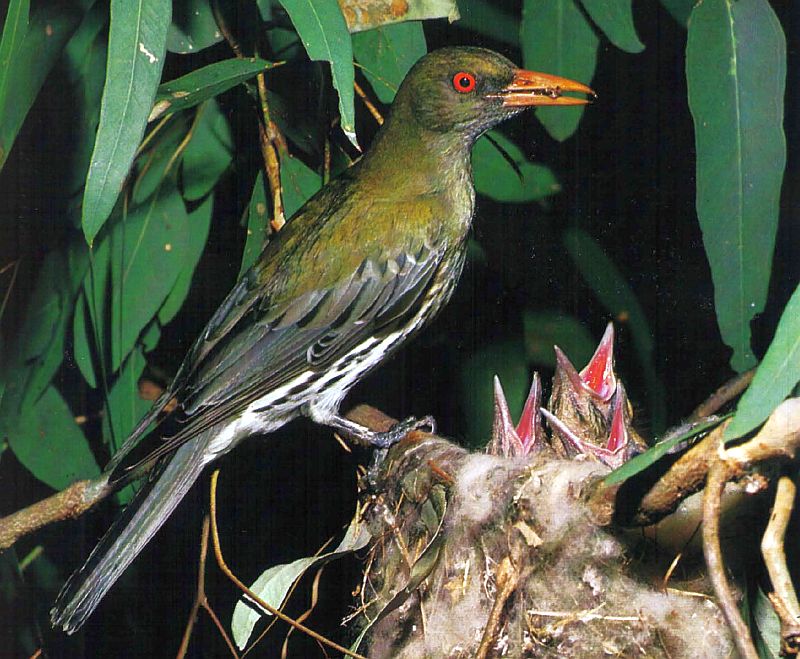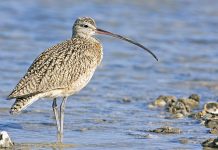Family: Olive-backed Oriole (Oriolus sagittatus) is a member of the family Oriolidae
Habitat: Olive-backed Orioles are birds of eucalypt woodland and open forest, living and feeding in the upper foliage and branches, singly and in dispersed pairs, in much the same way as the Yellow Oriole does in vine forest. The olive-backed oriole is widespread across northern and eastern Australia and south-central New Guinea. The olive-backed oriole overlaps the yellow oriole throughout its range. The two, however, do not compete because of their different needs in habitat, feeding, and movements.
Behavior: Compared to figbirds, which they frequently encounter foraging together, olive-backed orioles are less sociable. Established pairs sing regularly to one another throughout the year; it may help to maintain bonds. The female builds the nest in up to 13–14 days and then incubates; the male merely makes brief visits before hatching. Both parents feed the young through regurgitation. In plentiful seasons, the male may later take over care of the fledglings while the female nests a second time. Young birds are dispersed almost as soon as they become independent. Olive-backed orioles are frequently seen in urban parks and on golf courses, especially on trees that yield fruit.

Identification: The bird does not have vibrant colors as compared to other orioles. The male bird’s upper parts are, from head to scapulars, rump-rich olive-green with very faint black streaks. Wings and wing coverts are dusky, and the feathers are broadly edged and washed mid-grey. Tail mid-grey, the outer feathers narrowly to broadly tipped white. Chin grey-green streaked black, grading into white underparts marked with short black streaks. The eyes are orange-red, while the bill is dull brick-red. Feet are leaden grey. The female white-bellied oriole is more clearly streaked on the back and more coarsely streaked below; it is also slightly smaller. The immature bird is dull olive-brown above, often with a faint russet wash on grey wings; a faint buff eyebrow; buff tail tips; and dirty white underparts, heavily and coarsely streaked dusky. The eyes are red-brown, and the bill is dusky color.
Vocalizations: It is a somewhat noisy and conspicuous bird. The olive-backed Orioles call is rolling, mellow, bubbled olio, or orry-ol in contact. Harsh scolding note. SONG: Extension of contact calls, a rippling rolling, carrying olly-olly-olly-o-lol and variations. Shallower, less resonant, and more protracted than in Yellow Oriole. Also a subsong of scratchy warbles and mimicry.
Diet: Olive-backed Orioles are mainly fruit-eaters but do take insects, all gleaned from outer foliage and twigs: leaf beetles, ants, mantids, and caterpillars.
Movements: In their movements, the birds are much more nomadic than Yellow Orioles, and in the southeast, they are even migratory. Those south of about 2 7°S shift north to central and northeastern Queensland in autumn and south again in spring to breed. Strays from these movements sometimes reach the Mt. Lofty Ranges, SA. Flight is swift, silent, and undulates through treetops.
Nesting and Breeding: Olive-backed The oriole’s nesting and breeding occur in September and January. Nest deep and cup-shaped, of bark strips, leaves, grass, wool, or other soft plant material; suspended by rim from the thin fork in the outer foliage of a tree or shrub.
Eggs: The bird lays two to four eggs, cream, spotted, and blotched with grey and brown; oval, about 32 x 22 mm. Incubation is about 17–18 days for females. Young fledge in 16–17 days.
Distribution: Olive-backed orioles are found in eucalypt woodlands and open forests, infrequently in rainforest pockets of coastal and near-inland northern and eastern Australia, from Broome, Western Australia, to the southeast of South Australia, with outliers about Adelaide. Also found in southern New Guinea.
Taxonomy: Famous English ornithologist John Latham first described the olive-backed oriole in the genus Coracias in 1801.
Other Names: This bird is also known as ‘Green Thrush Oriole, White-bellied Oriole, and Cedar Bird.
Size: white-bellied orioles measure about 260–280 mm in length.
Subspecies
Four subspecies are recognized:
-
S. sagittatus found in eastern Australia (Latham, 1801):
-
S. affinis is found in northwestern and north-central Australia. Gould, 1848: Originally described as a separate species.
-
S. magnirostris found in south-central New Guinea, van Oort, 1910:
-
S. grisescens found on the Cape York Peninsula (north-eastern Australia) and the islands of the Torres Strait. Schodde & Mason, IJ, 1999:

This bird is also known as ‘Green Thrush Oriole, White-bellied Oriole, and Cedar Bird.






